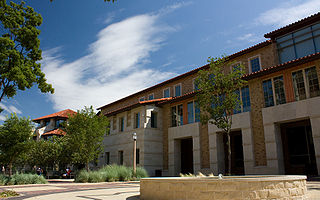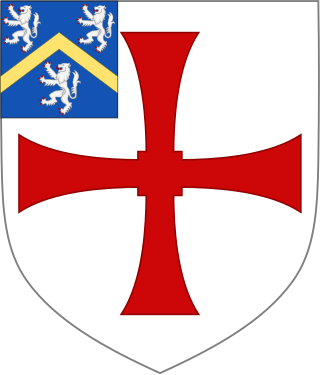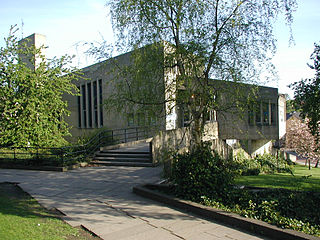Durham Students' Union, operating as Durham SU, is the students' union of Durham University in Durham, England. It is an organisation, originally set up as the Durham Colleges Students’ Representative Council in 1899 and renamed in 1969, with the intention of representing and providing welfare and services for the students of the University of Durham.

Birmingham Central Library was the main public library in Birmingham, England, from 1974 until 2013, replacing a library opened in 1865 and rebuilt in 1882. For a time the largest non-national library in Europe, it closed on 29 June 2013 and was replaced by the Library of Birmingham. The building was demolished in 2016, after 41 years, as part of the redevelopment of Paradise Circus by Argent Group. Designed by architect John Madin in the brutalist style, the library was part of an ambitious development project by Birmingham City Council to create a civic centre on its new Inner Ring Road system; however, for economic reasons significant parts of the master plan were not completed, and quality was reduced on materials as an economic measure. Two previous libraries occupied the adjacent site before Madin's library opened in 1974. The previous library, designed by John Henry Chamberlain, opened in 1883 and featured a tall clerestoried reading room. It was demolished in 1974 after the new library had opened.

Sir Denys Louis Lasdun, CH, CBE, RA was an eminent English architect, the son of Nathan Lasdun (1879–1920) and Julie. Probably his best known work is the Royal National Theatre, on London's South Bank of the Thames, which is a Grade II* listed building and one of the most notable examples of Brutalist design in the United Kingdom.
Brutalist architecture is an architectural style that emerged during the 1950s in the United Kingdom, among the reconstruction projects of the post-war era. Brutalist buildings are characterised by minimalist constructions that showcase the bare building materials and structural elements over decorative design. The style commonly makes use of exposed, unpainted concrete or brick, angular geometric shapes and a predominantly monochrome colour palette; other materials, such as steel, timber, and glass, are also featured.
Samuel Sanders Teulon was an English Gothic Revival architect, noted for his use of polychrome brickwork and the complex planning of his buildings.

A student center is a type of building found on university and some high school campuses. In the United States, such a building may also be called a student union, student commons, or union. The term "student union" refers most often in the United States to a building, while in other nations a "students' union" is the student government. Nevertheless, the Association of College Unions International has several hundred campus organizational members in the US; there is no sharp dichotomy in interpretation of union in this context. The US usage in reference to a location is simply a shortened form of student union building.

Dorman Long & Co was a UK steel producer, later diversifying into bridge building. The company was once listed on the London Stock Exchange.

Elvet is an area of the city of Durham, in County Durham, in England. It is situated on the opposite side of the River Wear from Durham Cathedral and forms the south-eastern part of central Durham. Elvet is currently unparished.

Kingsgate Bridge is a reinforced concrete construction footbridge across the River Wear, in Durham, England. It is a Grade I listed building. It was personally designed in 1963 by Ove Arup, the last structure he ever designed. Kingsgate Bridge connects Bow Lane on the peninsula in the centre of Durham to Dunelm House on New Elvet, which building Arup's studio also contributed, and opened in 1966. Kingsgate Bridge is thought to have been one of Arup's favourite designs of all: he had spent many hours working on every detail of the plans.

Henry Richard Yeoville Yardley Thomason was a British architect active in Birmingham. He was born in Edinburgh to a Birmingham family, and set up his own practice in Birmingham 1853–54.

The Barnes Wallis Building/Wright Robinson Hall is a university building in central Manchester. It forms part of the campus of the former University of Manchester Institute of Science and Technology, which merged in 2004 with the nearby Victoria University of Manchester.

The architecture of Liverpool is rooted in the city's development into a major port of the British Empire. It encompasses a variety of architectural styles of the past 300 years, while next to nothing remains of its medieval structures which would have dated back as far as the 13th century. Erected 1716–18, Bluecoat Chambers is supposed to be the oldest surviving building in central Liverpool.

Durham University is a collegiate public research university in Durham, England, founded by an Act of Parliament in 1832 and incorporated by royal charter in 1837. It was the first recognised university to open in England for more than 600 years, after Oxford and Cambridge, and is thus the third-oldest university in England. As a collegiate university, its main functions are divided between the academic departments of the university and its 17 colleges. In general, the departments perform research and provide teaching to students, while the colleges are responsible for their domestic arrangements and welfare.

Langham House Close on Ham Common in Ham in the London Borough of Richmond upon Thames is a development of three Grade II* listed buildings designed in 1955 by the British architects James Gowan and James Stirling. The Le Corbusier-influenced buildings were the architects' first major project working together and cemented their reputation as leaders amongst the Brutalist movement. The development was constructed during 1957–58 for Manousso Group.

Ringway Centre is a Grade B locally listed building located on Smallbrook Queensway in the city centre of Birmingham, England. The six-storey, 230 metres (750 ft) long building was designed by architect James Roberts as part of the Inner Ring Road scheme in the 1950s and is notable for its gentle sweeping curved frontal elevation.

James Pigott Pritchett, known as J P Pritchett junior or J P Pritchett of Darlington, was a British architect.
Robert Maguire (1931-2019) was an influential British modernist architect and leading thinker in the British liturgical architectural movement of the Church of England. Maguire’s St Paul’s Church at Bow Common was voted the best church of the twentieth century in the UK.

Birmingham New Street Signal Box is a railway signal box in Birmingham, central England, situated on the corner of Brunel and Navigation Streets and at the west end of the platforms of Birmingham New Street railway station. Opened on 3 July 1966, the brutalist structure is a grade II listed building for its architectural value and a prominent city centre landmark. It closed on 24 December 2022.

The Architects' Co-Partnership (ACP) is a firm of English architects, founded in 1939 as the Architects' Cooperative Partnership by recent graduates of the Architectural Association School of Architecture. It encouraged teamwork, and set out to be a practice in which all members would be equal.
















